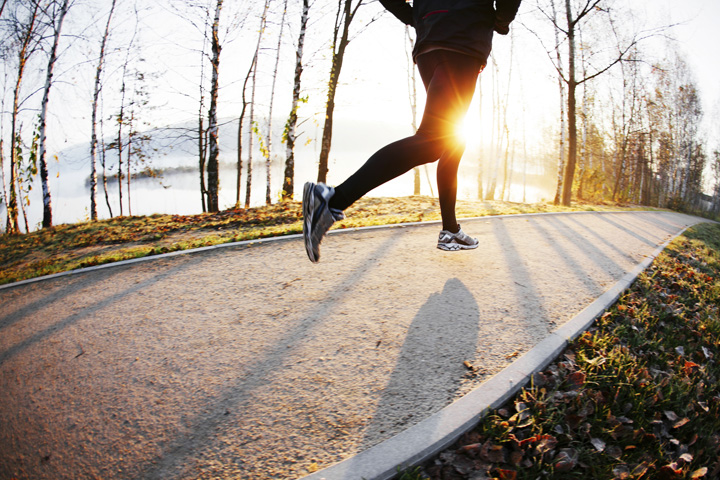
Increasing your cadence is a sure-fire way to become a more efficient runner
Good running technique is important. However, there is a lot of debate about what good technique actually looks like. Over the next few weeks I’ll be looking at different areas of running technique, so you can build up some general rules to follow as you look to improve your running.
One of the most talked about areas of technique is cadence. Running cadence is simply defined as how many steps you take in a minute. The easiest way to work your cadence out is to count how many times your right (or left) foot lands in a minute, double it and you’ll have your cadence. Many new Running watches, including the Garmin Forerunner 630 and 230/235 range will measure your cadence automatically, allowing you to view it during the run and afterwards. But what are we to do with this information?
First off, let’s discuss the 180 strides per minute claim that you may have heard about, and are told that is the cadence to aim for. The research this number is from was conducted by Dr Jack Daniels and is an AVERAGE cadence of elite distance runners. The actual figures were 180 and more. We aren’t elite runners and we are not an average! 180 is not the optimum cadence to aim for, everyone will have their own natural cadence which they find comfortable.
Why should you increase your cadence?
There are two reasons:
- To go faster
- To reduce injury
When we go faster, we have two options to achieve this:
- Take more strides per minute
- Go further with each stride
Now might be the time to go over your Garmin data and look at your cadence values, and see if it is any different when you are running faster and slower. You might also notice from this data that your cadence drops as you get fatigued.
Ideally we’ll have variations in your cadence, so your easy running might be at 160, and your quicker running might be 165. This is a good sign. However, you may find that there is no real variation in cadence, that gives you even more scope to work in.
Research from Heiderschei et al from 2011 concluded that ‘subtle increases in step rate can substantially reduce the loading to the hip and knee joints during running and may prove beneficial in the prevention and treatment of common running-related injuries.’ This sounds positive and it seems an increase in cadence is beneficial.
How do you increase your cadence?
As we already know, 180 is NOT the goal cadence for everyone, so what is? A ‘subtle increase’ would be defined as 5 – 10%.
First off, you need to set your own cadence zones up. If your cadence at easy running is 160 steps per minute, then you’ll want to increase that to 168 – 178. You can do this for a few other intensities and create some zones, however if you are new to running then just use your 5-10% zone from the Easy running as your goal.
| Effort Level | Current Cadence | 5-10% increase |
| Easy Running | 160 | 168 – 178 |
| Threshold Running | 165 | 173 – 181 |
| 10K/5K Pace | 167 | 167 – 175 |
Once you’ve done that, you have goal cadence zones to work towards. If you are new to this and aren’t sure about setting zones up,
During any run the LAST thing you want to do is go out and starting counting your cadence for the whole run, trying to make a change, it’ll drive you mad!
A metronome can be really helpful here, certain Garmin Watches (735XT, 920XT) have a metronome feature built in, and these watches will beep at you at regular intervals so you can start to practice running at that increased cadence.
Start working towards you’re new cadence goal wth short intervals, 1 – 2 minutes of work at a slightly quicker cadence (no more than 5% increase, perhaps was little as 2 – 3% to start with) but maintaining the same effort level (it will be tempting to run quicker at this new cadence, and it is great if you are running faster, but maintain the same effort level is vital). After this, continue running without thinking about your cadence. A first ‘session’ of training at this increased cadence might look as follows:
- 10 minutes easy running
- 1 minute easy running at a cadence of 163
- 10 minutes easy running
- 2 minutes of easy running at a cadence of 163
- 5 minutes easy running
- 3 minutes of easy running at a cadence of 163
- 5 minutes easy running
We haven’t got much running at the quicker cadence, but enough to give you a taste of what it is like. We need to be patient and slowly increase this time at a new cadence.
Take a similar approach into your interval sessions. Don’t try to increase the cadence for every rep; pick a few minutes of each one. You’ll probably find this really difficult towards the end of the session as you fatigue – I know I do!
There are no hard and fast rules for progressing here, you need to listen to your body. Slowly increase your cadence and the time you are running at the new cadence over time.
Give this a go for a few weeks and you might notice a change in your running, ideally for the better!
Got any questions, please hit me up on Twitter (@bennyFP) or email (ben@fullpotentail.co.uk) and I’d be happy to chat things over in more detail.
Ben has been coaching with Full Potential for 3 years, before this he worked with adidas, providing biomechanical support to runners all over the country. If you are interested in looking at Full Potential Coaching options, take a look at fullpotential.co.uk/coaching.






